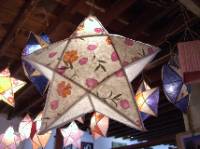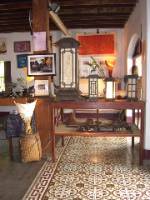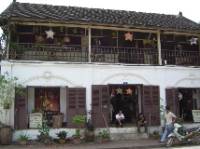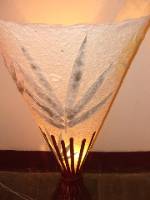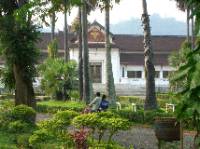Profile
Blog
Photos
Videos
Arrived in Luang Prabang comfortably by Lao Airlines today (one feels safe enough but the planes must be at least 20 yrs old and at Xieng Khouang airport there was no security check whatsoever ) and wondered how our Japanese travelling companion, Ogino-san, had actually managed to take the so-called, non-air-conditioned "VIP" bus for 8 hrs through the mountains on a very windy road, with the locals throwing up around him, the whole 200 or so km from here to Phonsavan (Plain of Jars/Xieng Khouang)! More about LP when we've got to know it better, but a quick check this afternoon revealed more tourists than we've seen since Angkor, but ALL IN ONE PLACE (a bit like Yangshuo on the Li river in China)! LP is situated at the confluence of the Nam Khan and the Mekong, Prabang refers to a prized gold, silver and bronze Buddha statue at the Royal Palace (we're in a communist country but the government didn't succeed in doing away with either Buddhism or royal relicts, including street names in this former royal capital), monks and wats are to be seen in all directions, and life appears to revolve around the long, straight main street, with its many shop-houses, reminiscent of the ones I used to be familiar with in Singapore back in the 60s. Cafes, restaurants, tour companies (esp. environmentally friendly ones with knowhow from the Aussies, Kiwis, etc. for trekking, kayaking and rafting), money-changers, artisans, street vendors at the night market - they're all here and it looks like the next 3 days are going to be fun.
Vientiane was a somewhat quirky kind of capital city. Population of only about 450,000 and much cleaner than most other places we've been to on this trip, but it still has a helluva long way to go before it can be regarded as one of the great capitals of the world. The concrete slabs covering the sewer are gravely deficient and occasionally completely lacking, the tuktuks swing precariously from side to side and one prays that Buddha (or the local spirits) will keep them upright while in motion, the wats mostly need a fresh coat of paint (one poor English girl had her camera stolen at the gorgeous but shabby Wat Si Saket - an unexpected disaster in Laos, where there is generally very little danger of crime against tourists despite the poverty prevailing; it seems there was a busload of tourists there when she put the camera down for a moment, though), and the Mekong waterfront (a nice place to eat in the evening, beside the virtually never-ending sandy beach that the river has become in this very dry month of March) is getting an injection of cash from the S. Koreans to transform it from a dustbowl into a promenade with a park. On the positive side, the food and drink has not made either of us sick anywhere in Laos yet, there are some lovely shops with the results of weaving projects among the women, especially in the ethnic groups (eg the Hmong), an English-language newspaper (the Vientiane Times) and great breakfasts, either with local Lao-style rolls or with bread, butter, jam and coffee - undoubtedly a legacy of the French period here. The Buddhist Pha Tat Luang was worth a tuktuk trip to the outskirts (it's the magnificent stupa that's pictured on the cover of my out-of-date 2005 "Lonely Planet" guidebook), the park around the Lao Arc de Triomphe, the Paduxai, an interesting study in Lao recreational habits (masses of people in the lovely surrounding gardens and relaxing beneath it in the shabby archway on a Sunday), and a tuktuk visit to the "jungle monastery", Sok Pa Luang, way out in the countryside, great value for a 30,000 Kip (US$4) full body massage. The herbal steam baths there also sounded (and smelt) heavenly! We also enjoyed the French and Lao food in Vientiane, the Scandinavian bakery and the fountain on Nam Phou square.
The National Museum, which used to be the residence of the French governor, leaves a bit to be desired as far as museums go but still enabled us to follow the history of Laos from the Stone Age to Khmer, Siamese and Burmese phases, up till the point where modern foreign devils arrived in Indochina in the form of first the French (masses of old French villas have been done up and converted into hotels or guesthouses) and later the Americans (who coopted a local ethnic group, the Hmong, to fight with them against the North Vietnamese). The royal family and the Lao patriotic movement succeeded in getting rid of the former by 1954 and the communist Pathet Lao the latter. By 1975 Laos was free, at least of unwanted foreigners. The museum would need a large injection of cash to make it state-of-the art, while an even larger injection, along with a huge donation from the USA to remove the vast amount of remaining UXO that they so inconsiderately dropped on the locals as well as the Viet Cong, would be necessary to get the local archaeological scene up to a scale comparable with that of western countries.
Sadly, the PL (unoficially) did the royal family in by banishing the king, queen and crown prince to a cave in the remote province of Hua Phan, where they died of malnutrition and untreated illness around 1981. In Luang Prabang, it's interesting to note, however, that the Royal Palace (up to the reign of the imposing statue in the garden there - King Sisavangvong, who died in 1959) is one of the main sights. Apparently the street names are constantly being changed, depending on the whims of the government, and currently, royalty is back IN - obviously because it's something most tourists enjoy being confronted with (even if the Pathet Lao doesn't):
- comments





